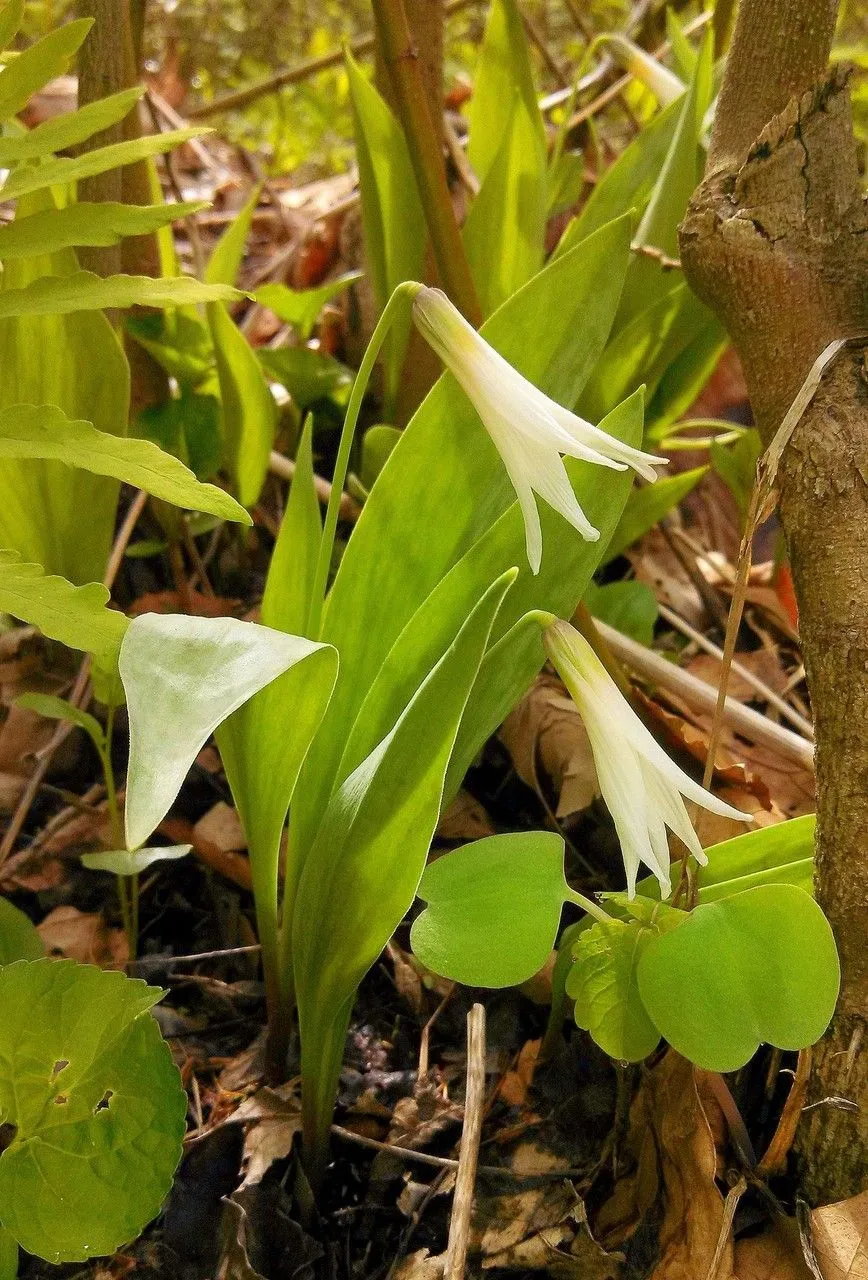
Author: Nutt.
Bibliography: Gen. N. Amer. Pl. 1: 223 (1818)
Year: 1818
Status: accepted
Rank: species
Genus: Erythronium
Vegetable: False
Observations: SE. Canada to C. & E. U.S.A.
The White Trout-Lily, scientifically known as Erythronium albidum, is a strikingly delicate plant belonging to the Liliaceae family. First identified and documented in 1818 by the botanist Nutt., this perennial herb is admired for its modest beauty and its connection to both the natural and cultural heritage of its native regions.
Commonly found in the southeastern parts of Canada and extending through the central and eastern United States, the White Trout-Lily flourishes in deciduous forests and shaded woodlands, often forming extensive colonies that herald the arrival of spring. The plant’s name is derived from its distinctive white, lily-like flowers and its mottled, trout-like leaves.
The White Trout-Lily produces its nodding, star-like blooms from late March to April. Each flower consists of six white tepals that may occasionally exhibit subtle pink or lavender hues. These tepals, as they mature, gracefully curve backwards, revealing the pure white or pale yellow stigma and anthers. The foliage, another identifying feature, includes a pair of basal leaves that are lance-shaped and heavily mottled with a deep green and purplish-brown pattern, mimicking the patterns seen on the skin of a trout.
Erythronium albidum has a specialized underground structure called a corm, which allows it to survive the harsh winters typical of its habitat. This adaptation is crucial for its early bloom, as the plant must make use of the brief period of sunlight available on the forest floor before the trees fully leaf out.
The White Trout-Lily holds ecological significance, serving as an early nectar source for pollinators such as bees and butterflies. It is also a species of interest for botanists and plant enthusiasts who are drawn to its ethereal beauty and its role in forest ecosystems.
Overall, Erythronium albidum is not only a botanical gem but also a reminder of the natural cycles and intricate interdependencies within our forests, deserving of study and conservation efforts to ensure its continued presence in its indigenous locales.
Swe: amerikansk hundtandslilja
Eng: white fawnlily, white trout-lily, white trout lily, small white fawn lily, white adder’s-tongue, white dog’s-tooth violet
Nob: hvithundetann
Nno: kvithundetann
Fra: érythrone blanchâtre
En: White trout-lily, White fawnlily, White Trout Lily, Small White Fawn-Lily, Small white fawn lily, White adder’s-tongue, White dog’s-tooth violet
Fr: Érythrone blanchâtre
De: Weißlicher Hundszahn
Nb: Hvithundetann
Nn: Kvithundetann
Sv: Amerikansk hundtandslilja
Taken Apr 7, 2021 by Theresa (cc-by-sa)
Taken May 2, 2021 by Hannah Prokop (cc-by-sa)
Taken May 9, 2020 by Ko Al (cc-by-sa)
Taken May 8, 2021 by Lowe Bryce (cc-by-sa)
Taken Mar 31, 2019 by McKenzie (cc-by-sa)
Taken Apr 27, 2021 by Tristan Demone (cc-by-sa)
Taken Apr 26, 2021 by lp pearson (cc-by-sa)
Taken Apr 14, 2021 by Philippe de Spoelberch (cc-by-sa)
Taken Apr 7, 2021 by Theresa (cc-by-sa)
Taken May 2, 2020 by paul runstedler (cc-by-sa)
Taken Apr 5, 2021 by wila0 (cc-by-sa)
Taken May 19, 2014 by EOL − David Yeany (cc-by-nc)
Taken Apr 24, 2014 by EOL − Matt Flower (cc-by-nc)
Taken Apr 27, 2014 by EOL − Fluff Berger (cc-by-sa)
Taken Feb 29, 2016 by EOL − Sam Kieschnick (cc-by-nc)
Taken Feb 28, 2016 by EOL − Sam Kieschnick (cc-by-nc)
Growth habit>: Forb/herb
Family: Myrtaceae Author: (F.Muell.) K.D.Hill & L.A.S.Johnson Bibliography: Telopea 6: 402 (1995) Year: 1995 Status:…
Family: Rubiaceae Author: Pierre ex A.Froehner Bibliography: Notizbl. Bot. Gart. Berlin-Dahlem 1: 237 (1897) Year:…
Family: Sapindaceae Author: Koidz. Bibliography: J. Coll. Sci. Imp. Univ. Tokyo 32(1): 38 (1911) Year:…
Family: Asteraceae Author: A.Gray Bibliography: Pacif. Railr. Rep.: 107 (1857) Year: 1857 Status: accepted Rank:…
Family: Fabaceae Author: Medik. Bibliography: Vorles. Churpfälz. Phys.-Ökon. Ges. 2: 398 (1787) Year: 1787 Status:…
Family: Aspleniaceae Author: (Cav.) Alston Bibliography: Bull. Misc. Inform. Kew 1932: 309 (1932) Year: 1932…